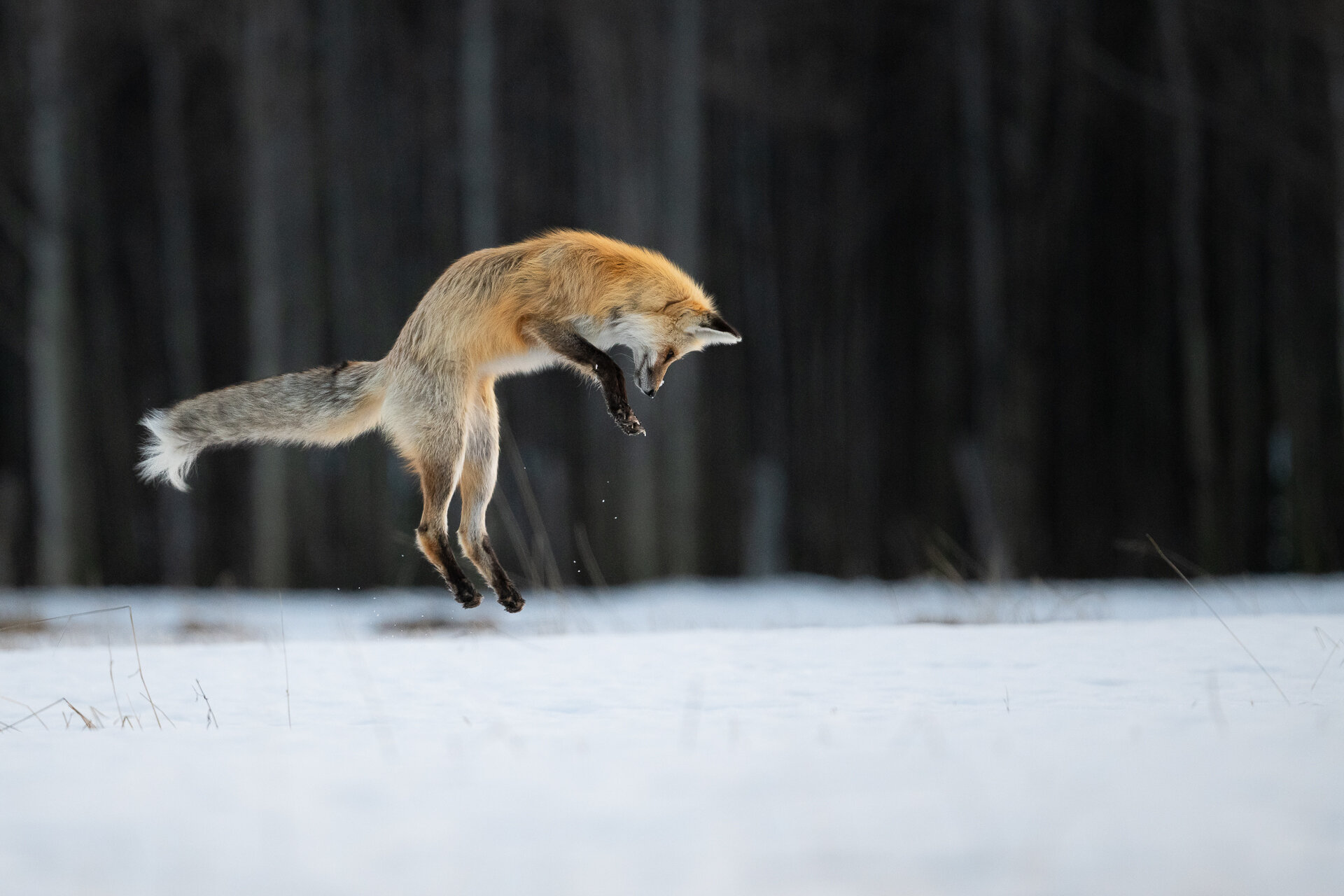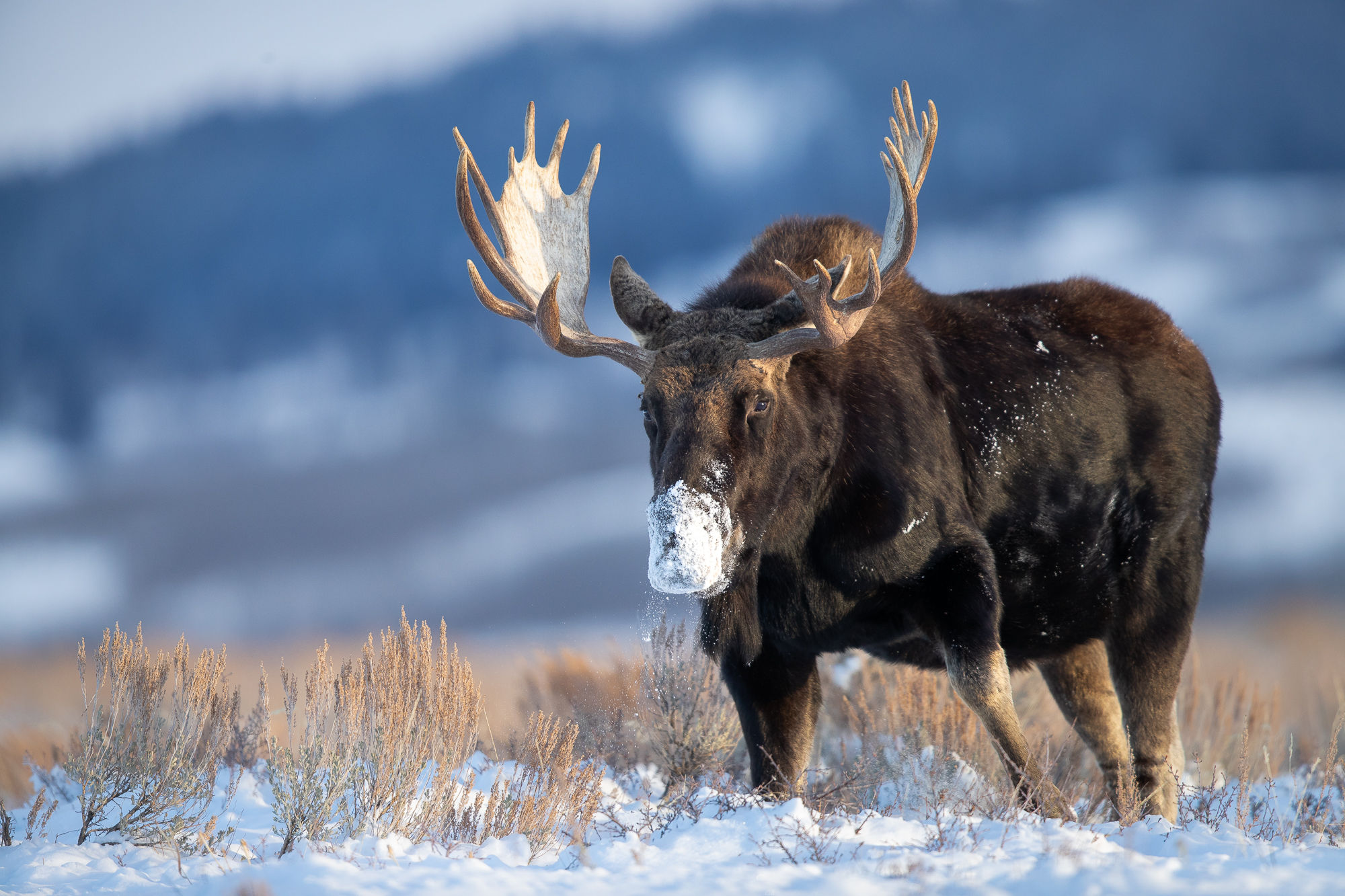It’s spring, finally. The snow is rapidly loosening it’s grip on the land. Pocket gophers and voles are still hunkered down beneath the small white patches that remain, and this experienced red fox is taking advantage of the cover that provides for hunting. Stay tuned to see whether she was successful...
Sunrise on the Firehole River
Sunrise on the Firehole River in Yellowstone. Yellowstone has no shortage of breathtaking rivers, but the Firehole is certainly chief among. Here, the water pools up before a waterfall plunges into a canyon.
Great Grey Owl in Grand Teton
The phantom of the north hunts the tree line during a snow storm at dusk. Great grey owls may sit perched for hours patiently listening for a rustle of movement beneath the snow.
What do moose eat in the winter?
Visitors to the Greater Yellowstone often look at the vast sagebrush and wonder what purpose it serves...other than catching your feet and tripping you on every step. Actually, this ecological community supports a remarkable diversity of wildlife. For example, sage brush flats provide critical winter habitat for moose. Such as the bull moose pictured here browsing on bitterbrush.
Tetons after a winter storm
The Grand Teton the morning after a winter storm. Seen here from the western side.
Ermine
Catching a glimpse of these little guys is always a treat...one that never lasts long. This is an ermine. Their coat turns from brown to white each winter, allowing them to be nearly invisible as they move through a snow white landscape. Their tail has a black tip on the end, which functions as a decoy luring any potential predators to strike there, rather than a more vulnerable part of the body.
Bull Bison in Grand Teton
This may be my favorite thing to see in the winter...a big bull bison covered in frost. The winter coat of a bison is so well insulating that there isn’t enough heat escaping their body to melt the frost. I’ve been able to photograph this bull several times over the last couple years. His exceptionally red coat, and the red patch on his face, make him easily recognizable.
Idaho Farmland
The simple clean landscape of the Idaho farmland near Driggs, ID.
Bighorn Rams in Jackson Hole
Bighorn sheep are fairly elusive for most of the year, as they spend most of their time in the mountains. In the winter they are forced down to lower elevations to feed and become much more visible.
Soaring over the Tetons
A Bald Eagle circles in front of the Teton range to make a second attempt at the raft of coots floating in the lake below.
Red Fox in Grand Teton
There are few things I find more visually striking than a red fox against the white snow. I found this fox as it was hunting for rodents under the snow. The fox will listen carefully for movement under the snow, turning its head back and forth to pin point the sound before leaping into the air and diving head first into the snow.
Tetons over Idaho
A slightly different view of the Teton Range...seen here from the western side towering over Idaho farmlands.
Bald Eagle Hunt
Bald Eagles key in on waterfowl in the late fall just before the ice takes hold and the open water is gone in Grand Teton National Park. When I arrived at the lake with. I first noticed the group of Red Heads. I looked around a bit more, and I noticed this eagle perched low and just out of sight along the river. I knew it was a matter of time before it made an attempt for the ducks. An hour or so passed and the eagle launched into the air. Flying low and using the topography to its advantage, the eagle had the element of surprise. Even still, it wasn't enough, and after five or six unsuccessful dives the eagle gave up for the afternoon. Nonetheless, it was an adrenaline rush watching the whole event unfold.
Bison - Winter Warriors
As winter settles and temperatures reach -40 degrees, perhaps no animal is as well prepared to survive in this unforgiving climate.
The distinct shoulder hump on their back, which is actually a protruding muscle, allows them to function as a 1 ton, living snow plow. Unlike other ungulates, such as moose and elk, which scrape with their front feet to access food under the snow, bison use this muscle to rock their massive heads back and forth exposing grass and sedge buried under several feet of snow. Some bison will opt out on this “snow-plow” technique, preferring to graze alongside thermal features where the warm steam from geysers or hot springs melts the snow on the surrounding grass.
When violent winter storms hit, prompting other wildlife to seek shelter from the chilling wind and blinding snow, bison just plop down where they are and wait it out. Their winter coats are so thick and well insulated that the falling snow doesn’t even melt on their back. In a heavy snow, you can watch the largest land animal North America vanish before your eyes in a matter of moments.
Teton Moose
I sat with this bull for a while recently as he browsed. This is largest moose I’ve seen this year. The light was pretty flat, but there was a brief 30 second window when the sun broke through and created a beautiful backlit scene against the falling snow....fortunately he picked that very moment to move to a new patch of bitterbrush
Tatanka
Sandhill Cranes
The call of the Sandhill Crane is one of the most distinct and beautiful sounds in the Teton valley. Their return each the Greater Yellowstone Ecosystem each Spring signals the changing of the seasons.
In Search of Great Grey Owls
It has been a challenging year for Great Grey Owls in the Tetons. With such a heavy snowfall, and repetitive thawing and freezing cycles, the snow pack was near impenetrable for these skilled hunters. Quite a few succumbed to the harsh conditions and were found dead. The ones that survived, managed to do just barely that, and did not have the strength to nest and raise chicks.
On a typical year I spend a lot of my time with these owls. So much so that is easy to take it for granted. My search, going on three months, for just one good Great Grey image has really made me appreciate the time I’ve had with them in the past.
After hearing about the appearance of one in the backcountry the other day, I dropped everything to investigate it. It took several hours of hiking, but just as the sun dropped behind the mountains I found the “Phantom of the North” hunting in an aspen grove. My time with her was brief, as darkness was enveloping the forest I still had to trek through to get back to the car, but I was reminded why I spend an inordinate amount of timing searching for just a moment with these birds.
Camouflage
When you walk past a pair of fledging Great Grey Owls several times before you even see them, the purpose of their feather coloration becomes obvious. While their temporary inability to fly poses a serious disadvantage, the ability to blend into any perch near seamlessly serves to protect them during their most vulnerable stage of life.
Ghost
A rare glimpse of a leucistic Great Grey Owl. This anomaly is caused by a lack of pigmentation. This was the male owl of a nesting pair. I had photograhed the females and two chicks for a couple weeks, but had not seen the male, who was typically off hunting, until this day. Just prior to the taking of this image I witnessed the most unique wildlife event of my life, a black bear and two cubs had attempted to climb the nest tree and eat the chicks. The female let out distress calls which prompted the male to come to the nest site, where they both repeatedly dive-bombed the bears until they retreated. After the whole ordeal, the male was tired and rested on this perch for several minutes.






















